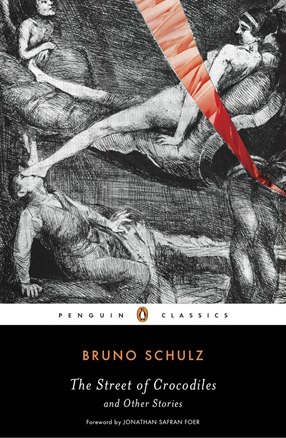Description
The collected fiction of "one of the most original imaginations in modern Europe" (Cynthia Ozick)
Bruno Schulz's untimely death at the hands of a Nazi stands as one of the great losses to modern literature. During his lifetime, his work found little critical regard, but word of his remarkable talents gradually won him an international readership. This volume brings together his complete fiction, including three short stories and his final surviving work, Sanatorium Under the Sign of the Hourglass. Illustrated with Schulz's original drawings, this edition beautifully showcases the distinctive surrealist vision of one of the twentieth century's most gifted and influential writers.
For more than seventy years, Penguin has been the leading publisher of classic literature in the English-speaking world. With more than 1,700 titles, Penguin Classics represents a global bookshelf of the best works throughout history and across genres and disciplines. Readers trust the series to provide authoritative texts enhanced by introductions and notes by distinguished scholars and contemporary authors, as well as up-to-date translations by award-winning translators.
About the Author
Bruno Schulz was a Polish writer, fine artist, literary critic and art teacher of Jewish descent. He was regarded as one of the great Polish-language prose stylists of the 20th century.At a very early age, Schulz developed an interest in the arts. He studied at a gymnasium in Drohobycz from 1902 to 1910, and proceeded to study architecture at Lwów University. In 1917 he briefly studied architecture in Vienna. After World War I, the region of Galicia which included Drohobycz became a Polish territory. In the postwar period, Schulz came to teach drawing in a Polish gymnasium, from 1924 to 1941. His employment kept him in his hometown, although he disliked his profession as a schoolteacher, apparently maintaining it only because it was his sole means of income.The author nurtured his extraordinary imagination in a swarm of identities and nationalities: a Jew who thought and wrote in Polish, was fluent in German, and immersed in Jewish culture though unfamiliar with the Yiddish language. Yet there was nothing cosmopolitan about him; his genius fed in solitude on specific local and ethnic sources. He preferred not to leave his provincial hometown, which over the course of his life belonged to four countries. His adult life was often perceived by outsiders as that of a hermit: uneventful and enclosed.Schulz seems to have become a writer by chance, as he was discouraged by influential colleagues from publishing his first short stories. His aspirations were refreshed, however, when several letters that he wrote to a friend, in which he gave highly original accounts of his solitary life and the details of the lives of his fellow citizens, were brought to the attention of the novelist Zofia Nałkowska. She encouraged Schulz to have them published as short fiction, and The Cinnamon Shops (Sklepy Cynamonowe) was published in 1934; in English-speaking countries, it is most often referred to as The Street of Crocodiles, a title derived from one of the chapters. This novel-memoir was followed three years later by Sanatorium Under the Sign of the Hourglass (Sanatorium Pod Klepsydrą). The original publications were fully illustrated by Schulz himself; in later editions of his works, however, these illustrations are often left out or are poorly reproduced. He also helped his fiancée translate Franz Kafka's The Trial into Polish, in 1936. In 1938, he was awarded the Polish Academy of Literature's prestigious Golden Laurel award.The outbreak of World War II in 1939 caught Schulz living in Drohobycz, which was occupied by the Soviet Union. There are reports that he worked on a novel called The Messiah, but no trace of this manuscript survived his death. Following the German invasion of the Soviet Union, as a Jew he was forced to live in the ghetto of Drohobycz, but he was temporarily protected by Felix Landau, a Gestapo officer who admired his drawings. During the last weeks of his life, Schulz painted a mural in Landau's home in Drohobycz, in the style with which he is identified. Shortly after completing the work, Schulz was bringing home a loaf of bread when he was shot and killed by a German officer, Karl Günther, a rival of his protector (Landau had killed Günther's "personal Jew," a dentist). Over the years his mural was covered with paint and forgotten.Source: wikipedia.com
